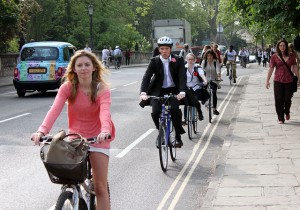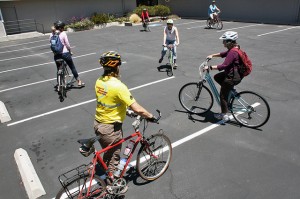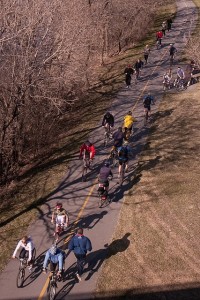In this section we deal with everything to do with cycling safety. There are many dangers on the road particularly when commuting in heavy traffic areas such as city centers. Within this section we give you all the information to make your cycle to work safer.
Cycling safety tips
 Getting on the bike for your first time to ride to work can be a daunting experience and many people are worried about safety. Like any new experience it can make you feel scared to begin with, but after a few times cycling to work you’ll be wondering what all the fuss was about.
Getting on the bike for your first time to ride to work can be a daunting experience and many people are worried about safety. Like any new experience it can make you feel scared to begin with, but after a few times cycling to work you’ll be wondering what all the fuss was about.
In fact, several recent studies have shown that the health benefits of cycling are far greater than any risks you take.
By following these six common sense tips, you can make sure that you stay as safe as possible on the road:
1. Keep a good road position – don’t ride in the gutter
2. Stay aware of hazards up ahead
3. Make eye contact with drivers
4. Signal
5. Stick to the lanes, just like a car
6. Do not overtake on the left, unless you are sure traffic has stopped
1. Road position
Take the lane – cycle in a position towards the middle of your lane. Don’t ride in the gutter. Riding to close to the kerb means that drivers may try to squeeze past you when there is not a safe amount of space to do so. Taking a position towards the middle of the lane makes sure that drivers must wait until there is a safe opportunity to overtake and it just makes you generally more visible.
Taking the lane may annoy drivers who are used to getting their own way, but you are entitled to do so. Don’t worry about holding up other traffic. But be sensible and considerate – if there’s not much traffic around, there’s no harm in pulling in briefly to let calmly waiting traffic past, if a safe opportunity arises. It’s live and let live! After all many of us are drivers too.
2. Stay aware
Scan the road ahead and identify potential hazards before they happen. An erratically driven car, an absentminded child about to step into the road, a large puddle. Don’t rely on other road users signals – some drivers will turn or change lane without indicating, other will indicate for no reason!
3. Make eye contact with drivers
The power of eye contact is amazing. A driver may not spot a cyclist at all but as soon as you stare directly at them, you magically come into focus. This is particularly useful when approaching junctions, like roundabouts, where drivers behaviour can be a bit unpredictable. Make eye contact with drivers – it’s help you read their intentions, and them yours.
4. Signal
One of drivers main issues with cyclists is that they are not sure what they will do next. Not all drivers are cyclists and vice versa. Let drivers know exactly what you are doing and it will make it safer for you. And remember you are not asking for permission – you are signalling what you are about to do.
Being well balanced on your bike is essential for safe signalling. Check the traffic ahead, and behind you, early on, so you can make your turn predictably. If you are confident, taking one hand off the bars can make looking over your shoulder much easier. Again it is a questions of practice.
5. Stick to lanes, just like a car, even on a roundabout
Do not hug the left edge on roundabouts with more than one lane! Do exactly what you would in a car – stay in lane, signal and filter off. This may mean you end up in the thick of the traffic but they will know exactly where you are, and will be able to predict what you will do next.
6. Only overtake on the left if the traffic is stationary
A very large number of cycle accidents involve careless drivers but equally there are many reckless cyclists. Overtaking on the left hand side is the most common mistake which can lead to a serious accident. If you are overtaking on the inside and a driver turns left without checking their mirror you will get squashed between car and curb. Only pass on the left hand side if the traffic is stationary and you are sure it will not start moving whilst you are carrying out the manouvere.
Things to watch out for when road cycling
 Vehicles turning left
Vehicles turning left
Problem If you are overtaking a vehicle on the left hand side and they decide to turn left they may not look in their mirror. In the case of large vehicles, like lorries and buses, you may be in their blind spot. This means at best you will end up screeching to halt, at worst in hospital.
For more information about why not to undertake long vehicles on the left consider to review the website of the City of London.
Solution Avoiding this is simple – do not overtake on the left hand side unless the traffic is stationary and doesn’t look likely to move off. It may look tempting at times but it really is dangerous.
Cars pulling out
Problem However much bright clothing you wear, sometimes drivers just don’t see you when pulling out on to the road.
Solution This is another reason to take a position more to the middle of the lane – not in the gutter – and to make eye contact with drivers. What’s more, keep your fingers on the brakes, just in case.
Opening car doors
Problem People getting out of cars on busy roads usually check the mirror, but sometimes they will miss a fast moving cyclist.
Solution Again, make sure that you take a position in the middle of the lane – this means you’ll be further away from any unwanted swinging doors and you won’t be trapped between car door and another vehicle should you need to take evasive action.
This is another occasion when a bell can be useful – if you see someone in a parked car preparing to get out, give your bell a ring just to let them know you are there.
Pedestrians
Problem As well as sharing the roads with cars, cyclists also have to share with people on foot. The main danger with pedestrians is that they often cross the road using their ears, listening for cars, but not looking that closely for bikes which don’t make that much noise.
Solution Once again, you are more visible more to the middle of the traffic lane and use your bell, just to let them know you are there. In built up areas with many people on foot, like central London, your bell is probably the most useful piece of safety equipment you can buy.
Three golden rules of cycling
Be courteous
While in a dream world, cyclists, drivers and pedestrians would all have their own roads and paths, this isn’t likely to happen in the foreseeable future.
So when on the roads, ride confidently, obey the rules and be courteous to drivers. If they left you out at a junction, slow down or give you a wide berth – let them know you appreciate it with a wave.
The more drivers get used to sharing the road with cyclists the safer riding will become.
Ignore dangerous cycle lanes
Some cycle lanes defy logic, starting and stopping for no apparent reason and being so narrow as to be totally useless.
Don’t feel that you are confined to them – if you don’t feel safe in the cycle lane use the full width of the road.
Take a safe route
Planning a safe route is the key to safe cycling. Obviously travelling down a bit of dual carriageway where some of the traffic is travelling at around 70mph isn’t a particularly safe place for a cyclist making headway at around 10mph.
There’s usually a quieter road, or even a cycle path these days, so use them. Ok, it may be the long way round but it’s likely to be a much more pleasant ride and you won’t annoy loads of drivers.
Cycle training
 Confidence is the key to many of these pieces of safety advice for cycling to work featured here.
Confidence is the key to many of these pieces of safety advice for cycling to work featured here.
- Having the confidence to ride out of the gutter with grumpy drivers beeping their horns at you.
- Having the confidence to make eye contact – knowing that you are the one obeying the rules of the road.
- Having the balance and poise to ride one handed whilst signalling.
All these things are improved through confidence.
The best way to improve your confidence, along with practice, of course, is a cycle skills training course. This will teach you the rules of the road, so you know what you are doing is correct, and also help develop and practice the actual skills in a safe environment.
Bikeability Training
The government approved Bikeability training scheme – touted as cycling proficiency for the 21st century – offers cycle course for adults around the UK. Some local areas offer subsidised lessons for adults, so check with you local authority first. If you live in London you can book subsidised lessons direct via the TFL website.
